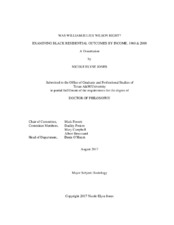| dc.description.abstract | Is the primacy of race on black residential outcomes not as salient compared to previous decades? This study tests William Julius Wilson’s out-migration thesis, a hypothesis indicating that the impact of race in shaping black residential outcomes is diminishing while the role of class is increasing over time. Stated differently, due to the combination of black upward mobility in socioeconomic standing and reductions in the severest forms of exclusionary discrimination, the relative and absolute salience of race in residential segregation is decreasing over time. If Wilson is correct, class would have increasingly important implications for determining black life chances, including residential mobility. To test the out-migration thesis, I use 1960 and 2000 census data where I perform two levels of analyses across 64 metropolitan areas. For the micro-level analysis, locational attainment is modeled to predict if (1) middle income blacks are living in higher income neighborhoods over time, (2) middle income blacks experience more parity contact with whites over time, and (3) middle income blacks experience more average contact with whites over time. Further, regression standardization and decomposition analysis allows for testing whether the role of income in black parity and average contact with whites is increasing over time. For the macro-level analysis, segregation within and between whites and blacks by income is computed at metropolitan-level segregation to determine if (4) middle income blacks are experiencing more contact with whites (at various income levels) across metropolitan areas over time and (5) middle income blacks are experiencing less contact with poor iii blacks across metropolitan areas over time. Micro-level results show that middle income blacks are living in higher income neighborhoods and experiencing more contact (parity and average) with whites over time. Additionally, the role of income for black parity and average contact with whites increases over time. Macro-level results show that middle income blacks are living in metropolitan areas with more unevenness and less exposure with poor blacks over time. Moreover, middle income blacks are living in metropolitan areas with less unevenness and more exposure with whites (regardless of income) over time. | en |


